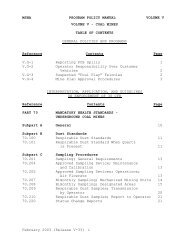MSHA HANDBOOK SERIES - PH13-V-1 - Mine Safety and Health ...
MSHA HANDBOOK SERIES - PH13-V-1 - Mine Safety and Health ...
MSHA HANDBOOK SERIES - PH13-V-1 - Mine Safety and Health ...
You also want an ePaper? Increase the reach of your titles
YUMPU automatically turns print PDFs into web optimized ePapers that Google loves.
COAL MINE SAFETY AND HEALTH<br />
GENERAL INSPECTION PROCEDURES <strong>HANDBOOK</strong> CHAPTER 3<br />
Documentation Required: The inspector should record in the inspection notes the<br />
beginning <strong>and</strong> ending point of travel in non-pillared worked-out areas (as correlated to<br />
a permanent reference on the mine map), the air quantity, the percentage of methane<br />
<strong>and</strong> the percentage of oxygen. The inspector is not required to document the<br />
inspection of non-pillared worked out areas by date <strong>and</strong> initials in the ITS. The<br />
inspector should clearly mark the extent of daily travels that contribute to the<br />
E01 inspection by date <strong>and</strong> initials on a mine tracking map <strong>and</strong> the beginning<br />
<strong>and</strong> ending point of each day’s travel for worked-out areas until each nonpillared<br />
worked-out area is fully inspected.<br />
11. Other Places Where <strong>Mine</strong>rs Work or Travel (Underground). The inspector<br />
shall evaluate the mine operator’s examination of other areas where miners<br />
work or travel. The inspector will assure all areas where miners are required<br />
to work or travel are examined in accordance with applicable st<strong>and</strong>ards.<br />
Locations of other areas where miners work or travel shall be maintained <strong>and</strong><br />
identified in the ITS. Other work areas <strong>and</strong> travelways should be inspected for<br />
compliance with applicable st<strong>and</strong>ards (example: high-voltage cable entries that<br />
are not located in regular travelways <strong>and</strong> other areas normally traveled by the<br />
mine personnel on a daily or weekly basis). The inspector shall look for<br />
evidence of examinations in the outby areas traveled <strong>and</strong> determine if the<br />
mine examiner had certified with dates, times, <strong>and</strong> initials (DTIs) that the<br />
required examinations were conducted for each area of travel. At least one<br />
test for oxygen (O2) deficiency <strong>and</strong> methane (CH4) content shall be<br />
conducted in each outby area inspected.<br />
Documentation Required: The inspector should record in the inspection notes the<br />
beginning <strong>and</strong> ending point of travel in other places where miners work or travel (as<br />
correlated to a permanent reference on the mine map), inspection of the mine<br />
examiner’s dates, times, <strong>and</strong> initials, the percentage of methane (CH4), <strong>and</strong> the<br />
percentage of oxygen (O2) (recorded in the inspection notes as a percentage).<br />
The inspector is not required to document the inspection of other areas where miners<br />
work or travel by date <strong>and</strong> initials in the ITS. The inspector should clearly mark<br />
the extent of daily travels that contribute to the E01 inspection on a mine<br />
tracking map <strong>and</strong> the beginning <strong>and</strong> ending point of each day’s travel for other<br />
places where miners work or travel, including the inspector’s initials, <strong>and</strong> date<br />
of inspection until each other place where miners work or travel is fully<br />
inspected.<br />
12. Outby Electrical Equipment. The inspector shall compare the mine operator’s<br />
record of weekly examination of electrical equipment to all electrical<br />
equipment in use <strong>and</strong> available for use at the mine. The inspector shall also<br />
ensure that permanent electrical installations are identified on the electrical<br />
map required to be maintained by § 75.508. A list of all electrical equipment in<br />
use <strong>and</strong> available for use should be maintained in the ITS. An inspection shall<br />
Release 1 (February 2013) 3-51
















